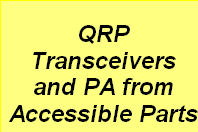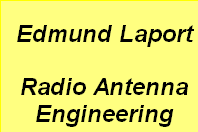|
The present describes a HF loop antenna and its agile coupler which can
be adapted to the new designs of ALE and FH (frequency hopping)
radiosets. The original specification in 1993 was
: "a small mobile antenna and coupler for HF voice
and data communications in driving from 0 to 600 km without silent
zone, in association with a 125 Watts CW radioset.
Frequency range 2-12 MHz Channel tuning time < 5ms Bandwidth >
3,5 kHz in a military environment" Following on from this
product other versions with wider frequency range (3-15 MHz, 3-30
MHz, 2-30 MHz), a higher power and various dimensions and shapes
for fixed, land-mobile and naval applications have been developed.
1. GENERALITIES
1.1. on
the HF tuned loops
The HF transmission tuned loop antennas which are designed for HF transmission
have small dimensions (< 0,1  ) compared to the wavelength,
in order to conduct a quasi constant current and to be considered
as magnetic dipoles. Their radiation impedance and efficiency
mainly depends on their surface which creates a magnetic flux
in the near field and an electromagnetic field in the far field.
Their diameter, height or width (round or square shape) run from
1 to 3 meters, and their radiating surface generally do not exceed
5 m2 in order to coincide with the small dimensions
required. ) compared to the wavelength,
in order to conduct a quasi constant current and to be considered
as magnetic dipoles. Their radiation impedance and efficiency
mainly depends on their surface which creates a magnetic flux
in the near field and an electromagnetic field in the far field.
Their diameter, height or width (round or square shape) run from
1 to 3 meters, and their radiating surface generally do not exceed
5 m2 in order to coincide with the small dimensions
required.
These types of antennas differ from open antennas (like whips, horizontal
dipoles, log-periodic antennas,) by their impedance which is reactive
and can be adapted by capacitor only. Their radiating resistance
is low (< 1 m  ) at the lowest frequencies of
the range. As the efficiency is given by the ratio radiating resistance/
total resistances of the tuned circuit, it is necessary to minimise
the radiating element resistor, using a good conductive metal
(aluminium, copper), and to use low loss capacitors. ) at the lowest frequencies of
the range. As the efficiency is given by the ratio radiating resistance/
total resistances of the tuned circuit, it is necessary to minimise
the radiating element resistor, using a good conductive metal
(aluminium, copper), and to use low loss capacitors.
|
These conditions beeing fulfilled, the loop
antennas deliver a high current and have a high selectivity with
a high quality factor (Q-factor), typically 10 times higher than
the Q-factor of the best traditional couplers designed for 5 to
10 meters whips or 10 to 40 m dipoles.
1.2 On fast frequency tuning
For future fast ALE procedures the tuning target time is 50ms, while
the "low speed" frequency hopping (F.H.) procedures
already require a 5ms tuning time, with all calculations and control
exchange times beeing included or already done. This can't be
done using electromechanical tuning. Digital switching devices
are cost effective today at low and medium powers. Their switching
time run in milliseconds using low loss vacuum relays, and in
the microseconds using electronic relays like PIN-diodes. But
the PIN-diode technology cannot be used in loops for transmission,
due to their inability to withstand the high currents and due
to the losses they bring (0.5 to 1 W) which would drastically
decrease the overall efficiency at the lowest frequencies. Vacuum
relays, including REED relays, are the only technologies available
to switch the capacitors of a transmission tuned loop antenna
efficiently.
1.3
On the power requirements
Based on the experience of 2 previous generations of tuned loop antennas,
and the proprietary propagation simulations, it was calculated
that two 100W radiosets and 4m2 loops having a -15
to + 5dBi typical gain figure from 2 to 12 MHz would insure voice
and data communications at any distance from 0 to to 600 km at
least.
This mission cannot be fulfiled by any 5 to 10 m whip
antenna on a medium soil, even in association with a 400W/1 kW
radio set: a vertical whip or a bent whip on a vehicle in move
do not transmit and receive enough energy to cover the typical
50-250 km silent zone.
|













